Kangnam 1/32 F-16A Fighting Falcon | 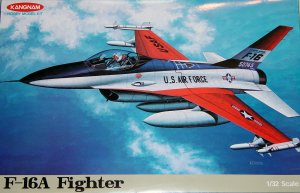 | Background The General Dynamics F-16 Fighting Falcon was winner of a lightweight fighter competition that pitted it against the Northrop YF-17 (that would later become the FA-18 Hornet). Not only would the F-16 serve as one of the mainstays of the USAF, it would also equip many air forces around the world, including Belgium, Denmark, the Netherlands, Norway, Israel, Turkey, Singapore, and many more. A slightly enlarged version of the F-16 would be developed in Japan and enter service as the F-2, while Taiwan would opt for a twin-engined version of the F-16 that was developed locally as the Indigenous Defense Fighter (IDF). Though Lockheed has since absorbed General Dynamics into its mega infrastructure (and it is still hard to say 'Lockheed F-16') and though Lockheed has moved on to build the F-22 Raptor and F-35 JSF, the F-16 production line remains open in Fort Worth Texas and is about to roll out the next generation of F-16 - the Block 60! The Kit 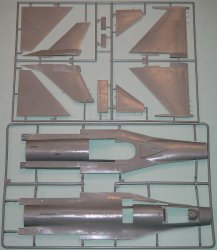 This kit is based on the original Hasegawa 1/32 F-16A Prototype kit. This release still featured raised panel lines, though it had raised the bar on out-of-the-box details with its highly detailed cockpit, radar, and gun bay. Molded in light gray styrene, the kit is comprised of well over 200 parts. The canopy and other transparencies are molded crystal clear. This kit is based on the original Hasegawa 1/32 F-16A Prototype kit. This release still featured raised panel lines, though it had raised the bar on out-of-the-box details with its highly detailed cockpit, radar, and gun bay. Molded in light gray styrene, the kit is comprised of well over 200 parts. The canopy and other transparencies are molded crystal clear.
The aircraft out of the box represents the early Block 1 prototype aircraft as test-flown in the US. This means that many of the significant details such as intake navigation lights, chaff/flare launchers, EW antennas, etc., are not represented anywhere. None of these items are difficult to fabricate, just take a look at some photos of the aircraft you wish to model. 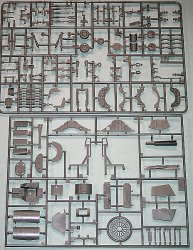 Nearly a ll of the early F-16As were retrofitted to the Block 15 standard which included a slightly enlarged horizontal stabilator. While most of the F-16As in the world appear to be the same, each has subtle differences in details, such as those with a parabrake housing on the tail - some had parachutes inside and others housed RWR equipment. Cockpit instrumentation varied sometimes and this open cockpit in the kit is a beautiful way to show off your detailing skills. Also look for the various types of navigation lights on the sides of the intake and different combinations of antennas and chaff/flare launchers as well (none of which are provided in this kit). Nearly a ll of the early F-16As were retrofitted to the Block 15 standard which included a slightly enlarged horizontal stabilator. While most of the F-16As in the world appear to be the same, each has subtle differences in details, such as those with a parabrake housing on the tail - some had parachutes inside and others housed RWR equipment. Cockpit instrumentation varied sometimes and this open cockpit in the kit is a beautiful way to show off your detailing skills. Also look for the various types of navigation lights on the sides of the intake and different combinations of antennas and chaff/flare launchers as well (none of which are provided in this kit).
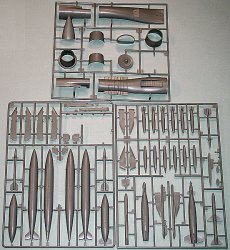 Since I have built the Hasegawa 1/32 F-16A before, I can attest that this kit has no surprises during assembly. The fit of the kit was great, just remember to dry-fit everything before using the glue of your choice. You'll definitely want to replace the ejection seat with one of the numerous aftermarket seats out there. Black Box also offers a complete F-16A cockpit which will bring the office up to Block 15 standard. Since I have built the Hasegawa 1/32 F-16A before, I can attest that this kit has no surprises during assembly. The fit of the kit was great, just remember to dry-fit everything before using the glue of your choice. You'll definitely want to replace the ejection seat with one of the numerous aftermarket seats out there. Black Box also offers a complete F-16A cockpit which will bring the office up to Block 15 standard.
The externals provided in this kit are not bad for your spares box but will not be usable for the F-16. The external fuel tanks in the kit are not accurate (Hasegawa later reissued their kit with accurate tanks). The AIM-9s are likewise best discarded. The AIM-7 Sparrow is nicely done, but wasn't carried on the F-16 (except for the highly modified F-16 Air Defense Fighter (ADF) variant). Two multiple ejector racks (MERs) are also provided with a full loadout of Mk.82 slicks. Unfortunately, the F-16 was never flight cleared for the MER, but it can carry the Mk.82 individually or in triples using the TER (triple ejector rack - not included). That leaves the empty pylons and the pair of GBU-10 laser-guided bombs (LGBs). These were approved (and used) on the F-16A on stations 3/4/6/7. You'll usually find them on stations 3/7 (middle pylons) as stations 4/6 were the only ones plumbed for external fuel tanks (as was the centerline station 5). 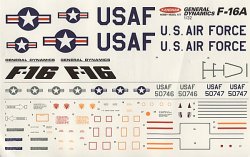 Markings are provided for the red/white/blue F-16A prototype 75-745 as well as 75-746 and 75-747 (aircraft two and three) in experimental gray paint schemes. Markings are provided for the red/white/blue F-16A prototype 75-745 as well as 75-746 and 75-747 (aircraft two and three) in experimental gray paint schemes.
Conclusion This kit has always built into an impressive model that has no bad assembly traits. If you can find one of the Hasegawa F-16s, you'll also note that the retail price of the kit is a little intimidating. This release from Kangnam will provide you with a lower cost option into the large scale Fighting Falcon model that you've been considering. Due to its size and complexity, I can recommend this kit to all but the beginning modeler. My sincere thanks to MRC for this review sample! | 








|

 This kit is based on the original Hasegawa 1/32 F-16A Prototype kit. This release still featured raised panel lines, though it had raised the bar on out-of-the-box details with its highly detailed cockpit, radar, and gun bay. Molded in light gray styrene, the kit is comprised of well over 200 parts. The canopy and other transparencies are molded crystal clear.
This kit is based on the original Hasegawa 1/32 F-16A Prototype kit. This release still featured raised panel lines, though it had raised the bar on out-of-the-box details with its highly detailed cockpit, radar, and gun bay. Molded in light gray styrene, the kit is comprised of well over 200 parts. The canopy and other transparencies are molded crystal clear. Nearly a ll of the early F-16As were retrofitted to the Block 15 standard which included a slightly enlarged horizontal stabilator. While most of the F-16As in the world appear to be the same, each has subtle differences in details, such as those with a parabrake housing on the tail - some had parachutes inside and others housed RWR equipment. Cockpit instrumentation varied sometimes and this open cockpit in the kit is a beautiful way to show off your detailing skills. Also look for the various types of navigation lights on the sides of the intake and different combinations of antennas and chaff/flare launchers as well (none of which are provided in this kit).
Nearly a ll of the early F-16As were retrofitted to the Block 15 standard which included a slightly enlarged horizontal stabilator. While most of the F-16As in the world appear to be the same, each has subtle differences in details, such as those with a parabrake housing on the tail - some had parachutes inside and others housed RWR equipment. Cockpit instrumentation varied sometimes and this open cockpit in the kit is a beautiful way to show off your detailing skills. Also look for the various types of navigation lights on the sides of the intake and different combinations of antennas and chaff/flare launchers as well (none of which are provided in this kit). Since I have built the Hasegawa 1/32 F-16A before, I can attest that this kit has no surprises during assembly. The fit of the kit was great, just remember to dry-fit everything before using the glue of your choice. You'll definitely want to replace the ejection seat with one of the numerous aftermarket seats out there. Black Box also offers a complete F-16A cockpit which will bring the office up to Block 15 standard.
Since I have built the Hasegawa 1/32 F-16A before, I can attest that this kit has no surprises during assembly. The fit of the kit was great, just remember to dry-fit everything before using the glue of your choice. You'll definitely want to replace the ejection seat with one of the numerous aftermarket seats out there. Black Box also offers a complete F-16A cockpit which will bring the office up to Block 15 standard. Markings are provided for the red/white/blue F-16A prototype 75-745 as well as 75-746 and 75-747 (aircraft two and three) in experimental gray paint schemes.
Markings are provided for the red/white/blue F-16A prototype 75-745 as well as 75-746 and 75-747 (aircraft two and three) in experimental gray paint schemes.






